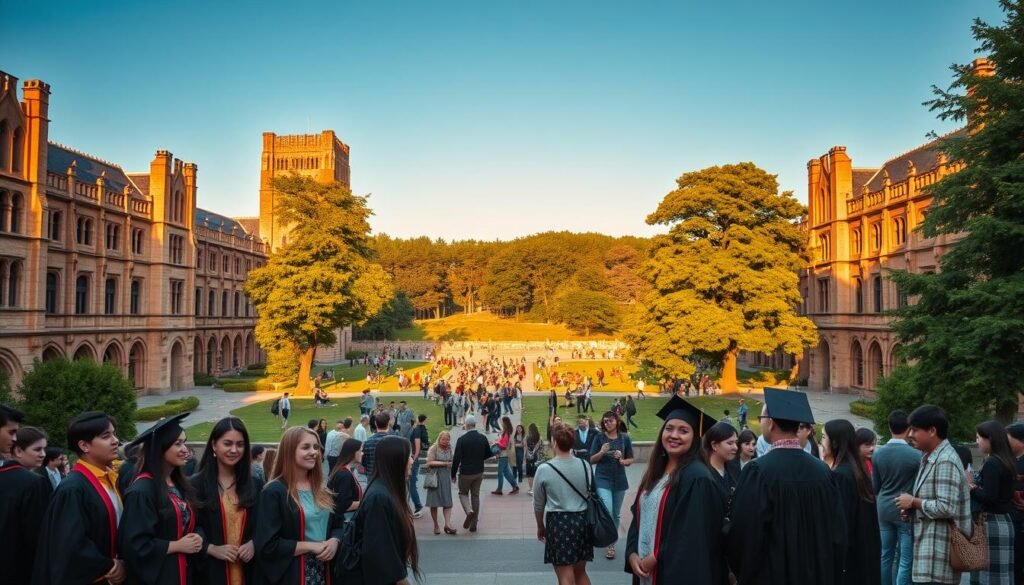
Surprising fact: more than one in five high‑achieving research applicants will be assessed for full funding when they lodge a course application this year.
This guide puts you on the hub page to understand how to make a strong case for the 2026 intake. You’ll get clear steps on who is considered for funding and what selection panels value.
You’ll see how automatic consideration works for new course submissions and what you must do if you’ve deferred or are already enrolled. We cover fees, stipends, relocation and health cover so you can plan your study and living budget with confidence.
By the end, you’ll know the timing to lodge your application and supporting materials, and where your research strengths might match supervisors and programs at university melbourne. This short intro sets the scene so you can take the next steps with clarity.
University of Melbourne Graduate Research Scholarships apply: 2026 intake at a glance
Get a compact overview of what the 2026 round delivers fees, stipends and extra support so you can plan your study and budget.
The package includes a full fee offset: two years for a Masters by Research and up to four years for a Doctoral degree. This means no upfront tuition while you study and predictable fee support across your candidature.
Stipend and allowances: the 2025 living allowance sits at $38,500 per year pro rata. It covers up to two years for a Masters by Research and up to 3.5 years for a Doctoral, with indexed increases and limited paid sick, maternity and parenting leave.
Relocation support helps when you move: $2,000 for interstate moves (outside Victoria) and $3,000 for moves from overseas. International students who need a visa get Overseas Student Health Cover (OSHC) Single Membership.
- Domestic students admitted to a Masters by Research or PhD receive an RTP fee offset with their course offer.
- Stipend places are competitive your course application usually triggers scholarship consideration.
- The overall benefits are designed to cut early costs so you can focus on timely research progress.
For a fuller summary and next steps, see the graduate research scholarships overview.
Eligibility and selection for 2026 graduate research scholarships
Understanding the rules will help you present the strongest case for funding.
You’re eligible if you’ve applied for and meet the entry requirements for a graduate research degree at university melbourne, or if you are already enrolled in the same stream. English language results must be valid and meet the degree requirements before the selection window closes.
How applicants are scored and ranked
Assessors score candidates on academic achievement from the last completed degree plus clear indicators of research potential.
Evidence can include refereed publications, relevant professional experience, specialist medical qualifications or original compositions. Scores are ranked against eligibility criteria and program needs across domestic and international cohorts.
Automatic fee offset for domestic candidates
All domestic students offered a place in a Masters by Research or a PhD receive an RTP fee offset automatically. If you’re an enrolled graduate seeking a stipend, you will still be assessed on merit alongside new applicants. These awards are subject to the Graduate Research Scholarships Terms & Conditions.
What the scholarships provide: fees, living allowance and support
Here’s a quick run‑through of what the funding package covers so you can plan your research and living costs.
Full fee offset for masters and doctoral degrees
The fee support is a full tuition fees offset up to two years for a masters research degree and up to four years for a doctoral degree. This removes a major upfront barrier and lets you focus on your project rather than tuition bills.
Living allowance amounts and duration
The living allowance for 2025 is $38,500 per year (pro rata). You can receive this for up to two years for a master and up to 3.5 years for a doctorate.
Allowance payments may be indexed annually and include limited paid sick, maternity and parenting leave so you have stability during key life events.
Relocation grant and health cover
A relocation grant supports moves to Melbourne: $2,000 from another Australian state or territory (outside Victoria) and $3,000 for international relocation. International students who need a student visa get OSHC Single Membership for health cover from day one.
Scholarship length and leave entitlements
Funding aligns to candidature limits, so plan timelines with your supervisor to use support effectively. Together, fee relief, the stipend, relocation and health benefits are designed so students can focus on timely, high‑quality research outputs.
«These benefits give you practical support to start and sustain your degree with fewer financial surprises.«
- Fee: full tuition fees offset (master up to 2 years, doctoral up to 4 years).
- Living allowance: $38,500 pa (2025, pro rata) for relevant years.
- Relocation & health: grants for moves and OSHC Single Membership for international students.
How to apply for the 2026 round
Submit your degree application by the course closing date and you’ll be automatically considered for graduate research scholarships at university melbourne. Within ten business days you should see a system notification telling you a scholarship application has been added to your record.
If you’re a new applicant to a graduate research course
Send your application before the course deadline. No extra form is needed at this stage. The system links scholarship consideration to your course submission.
If you’ve deferred or you’re currently enrolled
You must complete the online application by 31 October to be considered in the following year. Missing this date can delay assessment by years and affect your planned start.
Key dates, notifications and outcome timing
- Check notifications: expect confirmation within ten business days after your course application.
- Domestic offers: RTP fee offset appears with the course offer; stipend outcomes follow around the same time.
- Prepare documents: keep publications, referee details and program alignment current to strengthen your case for melbourne research scholarships.
Study areas and pathways to a competitive application
Match your research goals to the faculty strengths that will best support your project and career path.
Start by mapping your vision onto where the skills, supervisors and facilities sit.
Aligning your research potential with Melbourne’s strengths
Identify relevant schools medical, engineering, law, science, business, arts and music and note where your methods fit best.
Build a short list of supervisors whose recent publications and projects align with your field. Close alignment strengthens your study plan and selection prospects.
- Show continuity: link your prior degree training, methods and outputs to the program you want.
- Plan for progression: if you aim for masters research, explain how it can seed a doctorate; doctoral candidates should show readiness to publish early.
- Use facilities: cite labs, centres or performance spaces that support your work and boost your career impact.
- Make impact clear: outline benefits to communities, industry or policy so panels see a direct bridge from study to career outcomes.
Tailor your documents to highlight peer‑reviewed work, datasets or portfolios. This helps your case for melbourne research and for competitive research scholarships.
Ready to apply for 2026? Your next steps
A few practical actions will keep your scholarship candidacy strong and on schedule.
Confirm your eligibility, pick your degree and submit your course application early so you enter the 2026 assessment window. New applicants are automatically considered for graduate research scholarships and should see a scholarship entry added to their record within ten business days.
If you’ve deferred or are currently enrolled, complete the online application by 31 October to be considered for the following year. Domestic students get the RTP fee offset with their course offer; stipend decisions come around the same time.
Prepare selection-ready materials, double-check language results and supervisor fit, and plan housing, health cover and a study timeline that matches funded years. These steps make it easier to start and sustain your research career with the full benefits and support on offer.

